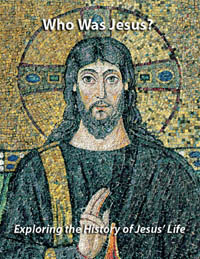Why Did Judas Identify Jesus with a Kiss?
The Late Hershel Shanks’s First Person from the January/February 2014 issue of BAR
Hershel Shanks April 05, 2022 97 Comments 43030 views

This text explains why Judas Iscariot identified Jesus with a kiss so that the Roman soldiers could arrest him, as related in three canonical gospels (Matthew 26:48; Mark 14:44; Luke 22:47). According to this late Gnostic gospel, that was the only way the Roman soldiers could be sure they had the right man. The reason was that Jesus could change his features:
“How shall we arrest him,” the Jews ask, “for he does not have a single shape, but his appearance changes. Sometimes he is ruddy, sometimes he is white, sometimes he is red, sometimes he is wheat-colored, sometimes he is pallid like ascetics, sometimes he is a youth, sometimes an old man, sometimes his hair is straight and black, sometimes it is curled, sometimes he is tall, sometimes he is short.” They “have never seen him in one and the same appearance.”
Jesus could also become completely incorporeal. Jesus explains that, if he wished, he could escape crucifixion in this way.
The idea of a shape-changing Jesus is not new. It goes back as far as Origen in the third century. According to Origen, Jesus would appear differently to people who saw him at the same time.


Van den Broek is careful to note that he is not suggesting that Jesus was in fact shape changing but only that some people in early Christian times may have thought he was.
This brings to mind another recent find with an unusual claim about Jesus—that he had a wife! In a papyrus fragment the size of a credit card, Jesus is speaking in the first person and refers to “my wife.” This Coptic fragment appears to have come from a Gnostic gospel of the fourth century and has been studied by Harvard Divinity School’s Karen King, who holds the oldest endowed academic chair in the United States. She has written a lengthy scholarly article on the fragment—dubbed the “Gospel of Jesus’ Wife”—that was accepted for publication by the prestigious Harvard Theological Review (see article.) Like van den Broek, King was careful to state (repeatedly) that this gospel fragment “provides no reliable historical information” as to whether Jesus was married, only that “some Christians depicted Jesus as married.” The claim that Jesus was married “arose over a century after the death of Jesus in the context of intra-Christian controversies over sexuality, marriage and discipleship.”
King was also careful to consider the possibility that the gospel fragment, which came from the antiquities market at least 30 years ago, was a forgery: “We took into serious consideration whether this was a genuine ancient text or a modern forgery,” she wrote. Two leading experts found that it was authentic, and various tests were applied. After her own study, King concluded that “although the authenticity is not absolutely settled beyond any question, we are sufficiently confident to offer our results here.”
After word got out that the fragment referred to Jesus’ wife, the Harvard Theological Review changed its mind about publishing King’s article. It had been scheduled for publication in January 2013. Under what pressure, we do not know, but the fact is that publication was postponed indefinitely—until the results of some unnamed tests by some unknown entities confirm the authenticity of the fragment. The magazine refused to divulge who would be conducting the tests or what they were. They referred to “various reports” that were expected, indicating that more than one test was to be made. The results of the tests, we were told, would be “ready for publication—hopefully early to mid-summer [2013].”a As of this writing, no information about these tests has been released, and the authorities still refuse to divulge who is doing the testing and what the tests are.
Why the difference between the reaction to King’s article, on the one hand, and van den Broek’s book, on the other? One refers to Jesus’ wife, and the other describes Jesus’ ability to change his appearance drastically. Is one more blasphemous than the other?
Several reasons have been suggested. Perhaps the question of Jesus’ sexuality is a more sensitive topic. Or perhaps the difference is that King’s analysis became public before it was published in the Harvard Theological Review, while the public learned of van den Broek’s shape-changing Jesus only after his book had been published. Or perhaps it was the fact that King’s gospel fragment “contains the first known statement that explicitly claims Jesus had a wife,” while references to Jesus’ shape-changing abilities were widely known previously in the scholarly community. Or maybe it was because there is no question about the authenticity of the document describing the shape-changing Jesus (it was bought from a monastery).
In any event, scholars are advised to step carefully when dealing with certain notions about Jesus held by some early Christians.
The Harvard Theological Review finally published Karen King’s paper on the Gospel of Jesus’ Wife in its April 2014 issue—along with several other articles on the Coptic papyrus fragment. Read about how the scholarly community has responded to recent tests conducted to determine its authenticity as well as why one Coptic manuscripts expert believes he has demonstrated that the gospel is a forgery.
Notes:
1. Roelof van den Broek, Pseudo-Cyril of Jerusalem “On the Life and Passion of Christ”: A Coptic Apocryphon (Leiden: Brill, 2013). Its retail price is $140.
a. See Strata: In Their Own Words: “Stop the Presses: Report on ‘Gospel of Jesus’ Wife’ Due Out Mid-Summer,” BAR 39:04.

